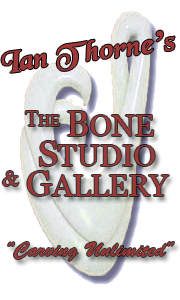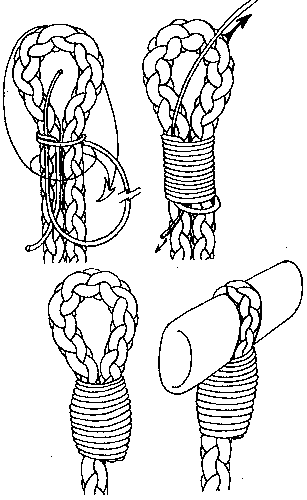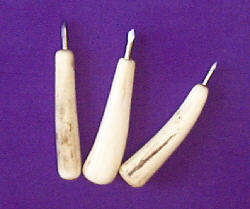
The Bone Studio and Gallery ... 
Template
Nothing beats hands-on instruction but, until many "net carvers" actually get down here to Aotearoa (New Zealand), it's difficult to get started carving. It's even more difficult without knowing which tools and materials to purchase so I will list the most essential purchases in the order they are used.
|
Bone Carving © by Steven Myhre |
|---|
Books
It's a good idea to know where you are headed before you start. My favourites are:
- Bone Carving by Steven Myhre
- Treasured Taonga by Ropata Davis and
- Symbols of the Maori World by Matthew Eru Wepa
Video
My millennium project, a hobbyist's video on bone carving, didn't happen (it may yet happen one day — but don't hold your breath!) However, there's enough information on this page that you should have a good start.
If you're interested in gravers, I include instructions with each graver set but it's no substitute for proper instruction!
Materials
The rear shin bone of a cow is the preferred bone for most carvers.
- Get it fresh with the ends cut off (it should be available from any butcher)
- Clean and scrape it thoroughly inside and out. Remove the marrow, etc.
- Wash in very hot water and detergent
- Place in large pot with hot water, detergent and an enzyme nappy (diaper) cleaner such as "Nappy-San." Triple the quantities recommended on the packet
- Stew gently for ½ hour then leave for a day or two to soak.
DO NOT BOIL -- this makes them hard and brittle - Rinse, re-scrape and dry
- Cut off oily parts of the bone (using a hacksaw) or the oils will spread through and discolour the white parts of the bone
Tools
- Fret Saw and Blades. Eclipse brand are reasonably tough, 16 or 18 tpi and preferably the black (not silver) type. Finer ones are available through jewellers suppliers
- Wood Rasp (to rough off the back if you don't have a drill)
- Dust Mask and Goggles (if you do have a drill)
- Files. It is very important to have the coarsest files possible. The only brands I use are both Swiss-made. Expensive but worth it!
- "Vallorbe" and "Baiter" always double 0-cut!
- ½ round ringmakers file (00-cut!)
- ½ round needle file (00-cut!)
- Round needle file (00-cut!)
- triangle needle file (00-cut!)
Don't let someone who doesn't know sell you something you can't use!
| Set of 3 Gravers NZ$100 + NZ$20 pack & post
|
|---|
- Gravers. These are high quality steel "chisels" made from "cobalt super" or "Assab 17" or similar. Only a carver will know how to make these. I can supply them, usually in a set of three, but many styles are created by carvers who spend enough time practicing. They are difficult to make well and useless if not!
- Small Vice. Very useful for cutting out design but don't hold your carving in it — it will snap! Leather jaws in your vice make it more versatile.
- Hand Ring-Clamp. Useful for holding small objects. Saves your fingers!
- Leather Rice Bag. Soft leather bag (firmly packed) to hold your carving while you work on it.
- Wet and Dry Sandpaper. I use several grades in succession. The first is most important as it must remove all scratches from files, etc. Then, progress through grades one at a time. Start on 150 or 240 grit, then 320, 400, 600 and 800.
- Polishing Gear. Easiest is Brasso (liquid brass/copper polish) but you must wash it off again. Best is stitched cotton bussing wheel on a grinder. Use a white "rouge" such as "tripoli White."
- Cord. Best to use "waxed nylon thread." Often used to stitch leather. Nylon doesn't rot so your carving is safer. I plait them and use "whipping" to tie up the toggle, loop and the carving for a strong, attractive finish.
- Whipping, Lashing and Binding Sorry, this is not instruction in B&D — it's to weave a "chain" to retain and display your Taonga. Whipping is made from a single looped strand of yarn with the ends pointing in opposite directions. The top part of the loop is wound around on itself until the desired number of turns are made. The toggle is fitted by adjusting the size of the eye or the loop can be made to go over the toggle. Once the whipping is correctly positioned, bind it in place by pulling the ends. Then cut off the ends carefully so the finished job is tidy. If using nylon, melt the ends carefully and "touch" them so they stick to the whipping.
- Common Sense! Without a teacher, this is your best tool. Look carefully at what you are doing and teach yourself. Beyond the basics, this is your only hope of achieving your goals. When in doubt, improvise!
Remember, you are creating Taonga (treasures) that may be around for centuries. Make them with respect and care so that someone will want to pass them on to their children.

